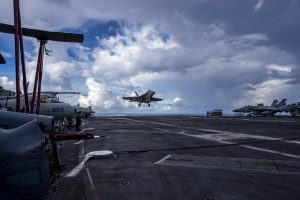On August 11, U.S. Defense Secretary Lloyd Austin ordered the accelerated deployment of the USS Abraham Lincoln (CVN-72) and its escorts from the West Pacific to the Middle East. This urgent redeployment was driven by escalating tensions in the Middle East, particularly the potential for Iranian retaliation against Israel. However, this strategic shift, intended to bolster U.S. presence in the Middle East, leaves a significant deterrence gap in the South China Sea and Taiwan Strait, regions where U.S. military presence is equally critical.
The Middle East has long been a focal point of U.S. military engagement, but the simultaneous need to maintain a strong presence in the West Pacific, especially in the face of a rising China, has placed unprecedented strain on U.S. forces. The redeployment of the Lincoln exemplifies this strain, revealing a growing challenge for the U.S. military: the difficulty of sustaining deterrence on multiple fronts. As the U.S. diverts resources to manage Middle Eastern tensions, it inadvertently signals vulnerability in the Pacific, where China has been steadily expanding its naval capabilities.
China’s military ambitions are increasingly evident, particularly in its naval advancements. Beijing is rapidly testing its third aircraft carrier, the Fujian, which, when fully operational, will be the world’s largest conventional aircraft carrier. Unlike its predecessors, the Fujian is equipped with advanced technologies such as electromagnetic catapults and arresting gear, allowing it to launch a variety of aircraft more efficiently. This leap in naval power not only enhances China’s ability to project power across the Asia-Pacific region but also poses a direct challenge to U.S. dominance in the seas surrounding Taiwan and the South China Sea.
In addition to the Fujian, China is developing the world’s first specialized drone aircraft carrier, a revolutionary vessel designed for unmanned aerial warfare. This drone carrier, also equipped with electromagnetic catapults, underscores China’s focus on modernizing its military with cutting-edge technology.
The primary objective behind these developments appears to be the eventual reclaiming of Taiwan, a goal central to China’s long-term strategic vision. Although China is unlikely to resort to military action against Taiwan in the immediate future, its expanding naval power enables it to subtly shift the balance of power in the region. China’s naval buildup is likely to have profound implications for U.S. influence in the West Pacific.
The Lincoln’s redeployment comes at an inopportune time: For the first time in a decade, the U.S. Navy is swapping out the aircraft carrier that is forward-deployed to Yokosuka, Japan. The USS Ronald Reagan departed Japan in May and will be replaced by the USS George Washington sometime this fall.
By capitalizing on the temporary reduction of the U.S. naval presence, China could increasingly assert its dominance in disputed waters such as the South China Sea. The Chinese military might not engage in outright confrontation, but it could exploit these opportunities to challenge U.S. naval transits, gradually eroding the perception of U.S. strength and resolve in the region. Over time, this could lead to a significant reduction in U.S. influence, particularly as regional allies and partners begin to question the reliability of U.S. security commitments.
Furthermore, China’s growing proactiveness in the West Pacific is likely to coincide with closer military cooperation with Russia. The two nations have already conducted joint naval drills and air patrols near U.S. and allied borders, signaling a united front against Western influence. As U.S. naval resources are stretched thin, China and Russia could intensify their efforts to test U.S. defenses, forcing the U.S. to focus more on protecting its own borders rather than projecting power abroad. This shift could diminish the United States’ ability to counter China’s strategic moves in Asia-Pacific and beyond.
The current tension in the Middle East underscores a broader challenge for Washington: the need to balance military commitments across multiple regions without compromising deterrence in any one area. The redeployment of the Lincoln is a clear example of the difficult choices the U.S. faces as it navigates an increasingly multipolar world. While the United States remains the world’s preeminent military power, its ability to maintain this status depends on its capacity to address threats in multiple theaters simultaneously.
The acceleration of the Lincoln’s deployment to the Middle East may be necessary to address immediate threats, but it comes at the cost of weakening U.S. deterrence in the West Pacific. As China continues to expand its naval capabilities and assert its influence in the region, the U.S. is naturally driven to find ways to mitigate the risks associated with these strategic shifts. This, as reported recently, might involve bolstering alliances with Australia, Japan, and South Korea in the Asia-Pacific, investing in more flexible and resilient military assets, or developing new strategies to maintain a credible presence in multiple theaters. Failure to do so could lead to a gradual erosion of U.S. influence in the West Pacific, with long-term consequences for regional stability and global order.

































